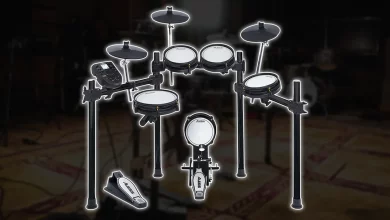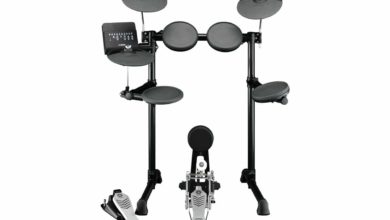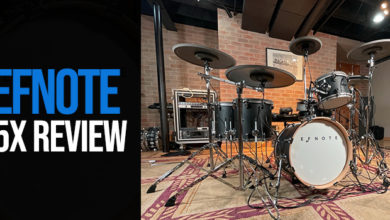
We may earn a commission from the affiliate links on this site. Learn more›
Not too long ago, I made a YouTube video detailing the differences between Alternate Mode’s malletKAT and the new Pearl
Unfortunately, that video was taken down due to my use of video footage from Pearl. I mistakenly figured it was fair use.
That being said, it sure is interesting that the same type of product from two different companies is stylized in the exact same way.
The malletSTATION is a great alternative to Alternate Mode's malletKAT. You will need a dedicated sound source.
What is the malletSTATION?
The malletSTATION is an electronic mallet controller, similar to that of a percussion instrument like a xylophone.
It functions as like a standard MIDI controller. You are able to play pitched notes with your sticks or mallets as long as you have some sort of sound source.
Electronic drums function in a similar manner. The only difference here is that the malletSTATION has no internal sounds or sound module.
Overview of the malletSTATION
On November 8, 2017, Pearl uploaded a video to their YouTube channel announcing the Pearl malletSTATION.
The model EM1 is a full-sized three-octave mallet controller designed for players of all genres and of all skill levels. This product is intended to directly compete with Alternate Mode’s malletKAT.
The malletSTATION is the “Next-Gen Mobile Mallet Percussion Controller “
The Keith McMillan-powered Pearl EM1 malletSTATION is a MIDI Marimba that is USB bus-powered that works in conjunction with your phone, tablet, or laptop.
It boasts an all-weather silicone playing surface; perfect for marching band pits when playing outdoors.
This is a solid feature, one that can’t be said about Alternate Mode’s MalletKat.
In terms of I/O, there are three expression pedal ports, giving you control over sustain, expression, and MIDI control changes.
The malletSTATION features a rugged aluminum steel chassis and works both with a traditional keyboard stand as well as a concert stand.
Overall Look and Design

The malletSTATION looks incredible. The design is sleek and modern-looking. The body is a hybrid aluminum and steel chassis.
It’s also very thin, measuring in at a slim 1.6 inches. The pads also look awesome, which are made from soft silicone.
There are No Internal Sounds
The big issue I see here is that the
I don’t see that being a total game changer, but I could see kids in marching band not wanting to use their iPhone or Android for the
It will drain their batteries, limit the use of their phones, and isn’t as convenient as just plugging a cable into an amp.
I guess it kind of bugs me that this thing is just a glorified MIDI controller. Maybe I am biased because I actually own a malletKAT.
Mine does include the internal sounds and I find that it is far easier to setup and play this way, rather than hooking it up to a computer and DAW with virtual instruments.
malletSTATION’s Price Point
The malletSTATION is much more affordable than the malletKAT.
That being said, it does seem that Alternate Mode is trying to lower the cost of their new instruments, as the malletKAT 8 was recently released at a far lower cost than what it was in the past.
Programming is Simple
The malletSTATION is also far easier to program since there are multiple buttons on the front panel.
With the malletKAT, you have to plug in a sustain pedal to one of the back
I feel like you may be limited with the Pearl, but it’s a great entry-level option for something like this.
Serious players will still use the malletKAT at the pro level, but finally, there are more companies actually pursuing the idea of electronic keyboard percussion.
No Traditional MIDI In / Out
Another bummer with the malletSTATION for me, at least from what I can tell, is the lack of traditional MDI inputs and outputs.
I understand that we are now in a USB world, but it would have been awesome if I could have linked this to say, my Roland SPD-SX and then from there I hit my DAW.
This now means I have to use two USB cables going to my computer rather than just one MIDI cable like with my malletKAT and SPD-SX.
Issues with Mallet Dampening and Velocities
Marimbalogy is a YouTube channel run by Charlie Nesmith that features lots of great content for marimba players and enthusiasts.
In his breakdown video of the malletSTATION, he demonstrates the following problems and spends a ton of time trying to fix the issue to no avail.
If you’re a marimba player I highly suggest checking out his channel for more awesome content.
The malletSTATION features technology that is supposed to allow mallet dampening, like you would do on say a vibraphone or marimba.
This is the act of physically muting the bar with your mallet.
Unfortunately, the instrument is pretty unreliable when it comes to dampening with the mallet.
When you go to perform a mallet mute, sometimes you’ll get a soft note canceling out the other note, sometimes it works, and sometimes nothing happens.
Inconsistent Velocities
When playing soft across the entire spectrum of notes, some of the velocities are way off from each other.
Initially I had thought that maybe it was inconsistency of the recorded samples, but this isn’t the case.
Wrapping Up
Alternate Mode recently released the malletKAT 8 which is significantly less expensive and, although there is no USB I/O, does seem to perform better in professional situations.
The malletSTATION is a great alternative to Alternate Mode's malletKAT. You will need a dedicated sound source.
By using the Pearl
I was originally a little cynical about the instrument, but as the weeks have gone on, I’ve realized that this is a strong competitor to Alternate Mode and that this is the future of mallet controllers.
The mallet dampening and the velocity problem are two giant issues Pearl must work hard to remedy before the instrument can be taken seriously at a professional level.
Quick Overview of Pearl
Pearl Drums was founded by Katsumi Yanagisawa in 1946. The company first began as a music stand manufacturer, but soon began making drum kits, marching drums, timpani, Latin percussion, cymbals, stands, and accessories.
In 1957, the company first began exporting instruments worldwide to meet the demand for drum sets following the big splash rock and roll music had made on Western culture. Today, Pearl’s Taiwanese five factories supply the entire worldwide market for Pearl products.
My first drum kit was made by Pearl: it was an Export Select Series in Cherry Red Wine. I’ve refinished it twice now and it still sounds great for a drum set from the late 1990s.
I have no doubt in my mind for Pearl’s quality standards when it comes to making great products.
This is the most affordable entry into MIDI mallet controllers, so I think it will be a successful venture for Pearl. What do you think? Leave a comment below and share the article if you enjoyed reading it!
Featured image courtesy of Justin Higuchi via Flickr.com.





Hello, I’d like to know if your opinion has changed now that the mallet KAT people have announced the MalletKAT 8 series with new features. There’s no question the price tag favors the Mallet Station but I’m considering which one of these could be my first keyboard percussion instrument and which is the best long term for reliability and durability (I play a little piano and had an intro to keyboard percussion in college, Im a drummer and latin percussionist).
0
Hi Herman,
Not entirely. I did see the announcement for the malletKAT 8, but the only big new feature is a discounted price tag. Everything looks identical to my eyes. I still see the same clunky navigation interface and still no USB output. I think Alternate Mode is concerned they will be losing sales to malletSTATION, as they most likely will. The malletKAT 9 needs a complete redesign of the user interface. The whole edit footswitch is BS.
I would hold off and go with the malletSTATION. It sucks that the moved the release date back into June now!
0
As to the August release date? FYI, I got mine a week ago by preordering.
0
Thanks David. Do you mind sharing where you pre-ordered from? I have noticed that both Guitar Center, Steve Weiss, and Sweetwater have them arriving soon. On the Guitar Center website, it says the EM1 will be in stock tomorrow. But they have changed that date multiple times since April of this year. The EM1 is also not available on Amazon yet.
0
I’ve owned a malletSTATION for a little over a year now and have used it on over 10 music theatre shows. Your review is very comprehensive and gives a great overview and comparison between the MalletKAT and the EM1. One point I would have to disagree with is the mallet dampening. I haven’t had any issues with this on my unit out of the box, but it is something that can be edited in the editor. I’ve even modified timpani patches to allow for mallet/finger dampening for appropriate cut-offs and it’s consistently worked. Individual users might have to fine tune the velocity and dampening sensitivity to suit their playing style.
0
Thanks for the input, Michael. I’m glad you haven’t had any issue with mallet dampening. I hope it was just a random fluke! I will be sure to update the article to reflect your experience to provide a more accurate look at the EM1.
0
Hi 🙂 the velocity and dampening issues are still there and it seems like pearl is deaf! after I send audio and midi files showing exactly what is happening NO REACTION till today (June 2019)
I feel really left alone with this product which is really useless the way it is now!
cheers
0
Hi Eddy,
Sorry to hear about your issues. It is a shame. I appreciate you informing us, and everyone else who reads about your problem! Cheers.
0
It’s too bad pearl didn’t offer a plug and play version for a little more. I think the company overlooked the set up and play crowd. With onboard sounds I would order it in a second.
0
Sandy … I don’t know about having onboard sounds as it might be limiting to its users. I like the flexibility it has even with the some of the issues mentined.
0
“Issues with mallet dampening and velocities” was fixed a LONG time ago in a software upgrade I think, as well as a note regarding start-up protocol (not leaving anything, mallets, etc., resting on the malletstation during boot:)
0
Don’t waste your money on a MalletStation. They are poor quality and unreliable. My second one (first one was replaced under warranty) is also now away for repair with only 4 months of light use. Pearl it seems could not care less. I expect that once existing manufactured stocks are exhausted they will let it die – and they should. This is an instrument that promised so much and if built to the right quaity probably would deliver – however it’s construction is cheap and unrelaible. Give it a miss.
0
I bought one of these a couple years ago, and hardly used it. Tonight I took the MalletStation to a jam session and one of my bandmates hit it quite hard while trying it out. Now one of the keys hardly responds at all. I agree that the lack of built-in sounds and lack of 5-pin MIDI are severe shortcomings for what is arguably a “professional” controller. I think it’s actually targeted at classrooms, not performers. It’s not as expensive as the MalletKAT, but it’s not cheap and if I’d known how fragile it is, I would never have bought it.
0